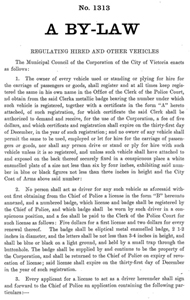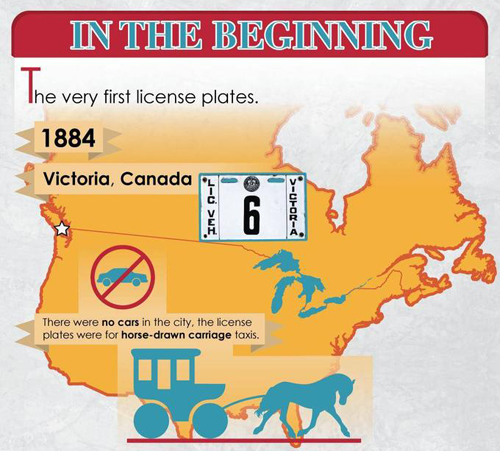This is NOT the "World’s Oldest License Plate"!!!!
|
|||||||||||||||||||||||||||||||||||||||||||||||||||||||||||||||||||||||||||||||||||||||||||||||||||||||||||||||||||||||||||||||||||||||||||||||||||||||
"bun fight": a heated altercation, but one that is ultimately of no importance. |
The No. 6 license plate shown above was issued by the City of Victoria to operators of "Hired Vehicles" (i.e. automobile taxis and horse-drawn carriages) in 1913 and was manufactured by the McClary Manufacturing Company of London, Ontario. Unfortunately, in October of 2010, the venerable Guinness World Records was persuaded that this plate had actually been issued almost 30 years earlier when the City passed its first bylaw (No. 100) to regulate the operation of hackney carriages within Victoria and, therefore, constituted the "World's Oldest License Plate"! This claim flew in the face of conventional wisdom, which for decades had held that the first automobile license plates were issued by the Department of the Seine under the Paris Police Ordinance of August 14, 1893, which stated that:
The requirement for motor vehicles to carry license plates was extended to the rest of France under a decree passed on September 30, 1901 and was applied to any vehicle capable of exceeding 30km/h. The oldest surviving license plate issued to an automobile is reported by the "Robertson's Book of Firsts" to be the No. 1 plate from the German State of Bavaria, which was issued to the brothers Hermann and Daniel Beissbarth - local automobile manufacturers - for use on their Wartburg car by the Royal Bavarian Police on April 14, 1899: |
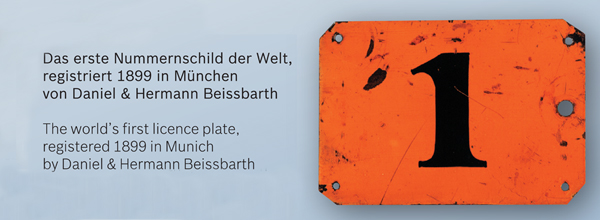 |
The first porcelain license plates only appeared ten years later when the Commonwealth of Massachusetts and the City of Philadelphia used the material in 1903. Upon review, the evidence submitted in support of the World Record claim proved dubious and failed to provide a direct link between the 1884 City of Victoria Bylaw and the issuance of the porcelain plates. Conversely, the weight of historical evidence that the No. 6 plate dated from 1913 was significant and prompted Guinness to revoke the "World Record" for the oldest licence plate in January of 2011, and to retire the category. While a more detailed account of this episode is presented in Chapter 8 of Tales from the Back Bumper: A Century of British Columbia Licence Plates (available in fine on-line bookstores everywhere), readers of this web page are asked to consider the following: |
|
.jpg) |
As can be seen in the No. 1 plate shown at left, the design of the plate corresponds exactly to the specifications outlined in Bylaw No. 1313, which was passed by City of Victoria Council in 1912. The dimensions of this plates are, not surprisingly, eight by five inches, with the number exactly three inches in height and the City's Coat of Arms clearly visible at the top of the plate. Guinness World Records was not made aware of the existence of the No. 1 plate - which, naturally, would be "older" than the No. 6 - prior to issuing its "World Record" in 2010. |
There are also the striking similarities that exist between the City of Victoria plates and those issued by the Provincial Police in 1913. Given that the Provincial Police maintained their head office in Bastion Square, only a few blocks from Victoria's City Hall, it would not be unreasonable to conclude that the two levels of government may have worked together on the introduction of new plates in 1913. |
|
The McClary Manufacturing Company of Toronto, which is confirmed as the manufactured of the 1913 BC plates, is notorious for having recycled the same basic license plate design amongst its various clients in Western Canada between 1911-1913: |
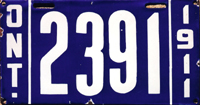 Ontario - 1911 |
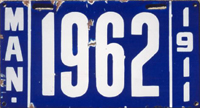 Manitoba - 1911 |
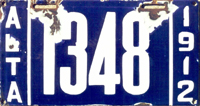 Alberta - 1912 |
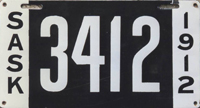 Saskatchewan - 1912 |
There also exists an interesting piece of correspondence from 1913 at the Provincial Archives in which the Superintendent of Provincial Police has written to his counterpart the Secretary of State in Sacramento, California, wanting to know what material was currently in use on their licence plates and whether officials and motorists were pleased with it? This was because, as he wrote, “this year (1913) we are using enamel and find that many automobile owners complain that they chip very easily and become disfigured.” Had the City of Victoria been using porcelain plates since 1884, this issue of chipping and disfiguration would not have come as a surprise to the Superintendent, who was a resident of the City. |
| Known Examples of the 1913 City of Victoria License Plate |
 |
When telling David's dad of thier plate spottings one July day, he asked the boys if they woudl “like to see a really different license plate?” He then proceeded to show the boys the No. 89 City of Victoria porcelain plate he had unearthed in the backyard fourteen years earlier (1950). The next day, the boys convinced Teddy's mother to take them down to the main office of the Motor Vehicle Branch (MVB) and then to City Hall to see if staff could shed any light on the plate. Staff had no records of such a plate, but thought it might have been issued to a “horse and buggy firm.” Not to be deterred, the boys then turned to the local press in the hopes that an “old-time” resident might be able to shed some light on the plate.
Howroyd had no idea what purpose his plate had been issued for and had nailed it to a hanger at the Butler-Howroyd Airstrip on the Saanich Peninsula, but “no one who has seen it has volunteered any information.” While the No. 89 is known to still exist and is in the hands of collectors, Howroyd's No. 98 has not been seen in modern times. |
 A hanger at the former Butler-Howroyd Airstrip (circa 2007?) |
| But don't just take our word for it ... |
| On February 12, 1913, the Victoria Daily Times ran a story announcing that the City Inspector had received a shipment of 500 license plates for use on the hired vehicles of the city, including express wagons, and that these plates "resemble greatly automobile plates, but the colors are different. Fine, clear black numerals stand out on a white field"! |
| The column goes on to explain that the plates are to be placed on the off side of waggons while "hacks" will carry them on the back "in the same place and manner as automobiles" [emphasis added] |
| One of the odder arguments put forward in support of the discredited theory that these Victoria plates were issued in 1884 is that they served as the inspiration for the subsequent design of automobile license plates. |
| We think this to be an absolutely fantastical notion as well as patently absurd, and one that is further debunked by the Daily Times's contemporary reporting on the subject and the need to explain the "Cab" plates to their readers in the context of the more commonly understood automobile license plates. |
| News Stories - "World's Oldest License Plate" |
| "Most Expensive License Plate" - The Most Expensive Journal (2009-12-09) LOOK FOR POST BY "JOHN ROBERTS" |
| "World's Oldest Licence Plate" - Senior Living Magazine (2010-03-01) |
| "World's first licence plate issued in Victoria in 1884" - Victoria Times-Colonist (2010-10-19) |
| "Victoria is the birthplace of the licence plate" - Victoria Times-Colonist (2010-10-19) |
| "B.C. man has world's oldest licence plate" - Calgary Herald (2010-10-20) |
| "World's oldest licence plate cost Victoria drivers $1 a year" - Vancouver Sun (2010-10-21) |
| "Collector's query 'oldest' licence" - Victoria Times Colonist (2010-10-23) |
| "The World's Oldest Number Plate?" - Regtransfers.co.uk (2010-10-??) |
| "Oldest licence plate in Victoria" - Victoria News (2010-11-04) |
| "World's oldest number plate on sale for Dh29m" - Gulf News (2010-11-21) |
| "World's Oldest Number Plate on Sale for $7.9 Million" - PRLog (2010-12-17) |
| "Guinness revokes licence plate record" - Victoria News (2011-01-28) |
| "Brake put on Victoria's claim to oldest licence plate" - Victoria Times-Colonist (2011-02-02) |
| "As It Happens" Radio Broadcast - Canadian Broadcasting Corporation (2010-02-03) JUMP TO THE 23 MINUTE MARK |
| "Brakes put on world's oldest licence plate claim" - The Globe and Mail (2011-02-06) |
| "Former Burtonian has oldest licence plate" - Burton Mail (2011-02-22) |

*
* * * * |
| Postscript |
Prior to the revocation of the "Record" by Guinness, it came to light that a number of other carriage plates were known to exist and were decidedly older than either than 1913 porcelain plates issued by the City of Victoria, or its 1884 Bylaw regulating hackney carriage operators. |
These include examples of a "Royal Postal Plate" purportedly affixed to carriage carrying mail during the reign of King George III in the late 1700s or early 1800s; a dated 1860 carriage plate from St. Petersburg, Russia; as well as another carriage plate from New Orleans, Louisiana from the 1870s: |
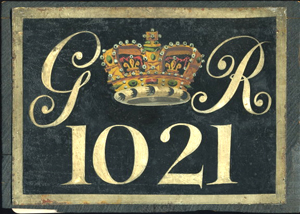 1800-1820(?) - United Kingdom |
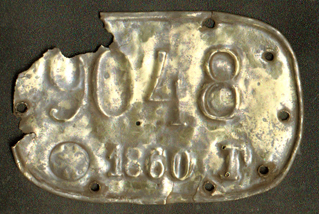 1860 - St. Petersburg |
|
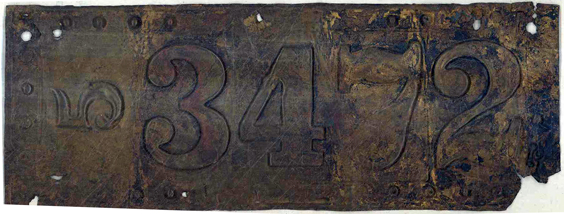 1879 - New Orleans |
||
As all of these examples are from carriages, it is questionable if they can even be considered as representing the first modern license plate, which would generally be associated with an automobile. |
An advertisement was also placed on the on-line classified site: UsedVictoria.com a few months after the record was revoked (March of 2011) offering the princely sum of a $100 "reward for old photo of Victoria carriage licence plate, 1800's". |
Of course, we here at BCpl8s.ca consider such a request a nonsense as there would have had to have been a rupture in the space-time continuum over Victoria sometime in 1913, thereby allowing an unsuspecting taxi driver with a 1913 City licence plate on their vehicle to fall in and re-emerge in 1884 Victoria where, miraculously, they would be photographed - quite by accident ... and, well, you get the "picture". It is a highly unlikely, if not impossible scenario ... Hopefully, UsedVictoria.com does not charge too much to post and renew a listing on their site ... |
*
* * * * |
An unfortunate aspect of this story is that the dissemination of information on the internet has made it very hard to stamp out the notion that the City of Victoria was issuing license plates in 1884 and that these were the first such plates of their kind. |
While we are certainly impressed with the time that "DriveSteady.com" put into creating the graphics associated with a column on the history of the license plate - "From the first plate to police readers catching thieves" - (August 17, 2011), we are disappointed that otherwise sound research has been marred by the inclusion of a reference to the City of Victoria as having issued the first license plates in 1884! DriveSteady is "all about getting you new and interesting information about the automotive industry in imaginative ways" so we are hopeful that this mistake can be rectified. |
Another instance occurred with a DRAFT of the American Association of Motor Vehicle Administrators (AAMVA) study entitled; Best Practices Guide for Improving Automated License Plate Reader Effectiveness through Uniform License Plate Design and Manufacture, that was released in July 2012: |
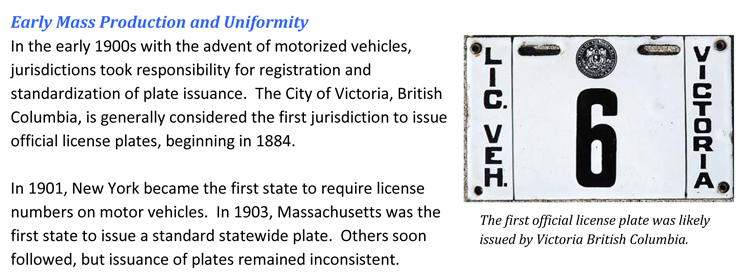 |
Luckily, this was rectified prior to the formal release of the document, however, the Virginia Department of Motor Vehicles did not fact check the information in their License Plate Study: An Assessment of the Current State of License Plates and Their Potential to Promote Public and Highway Safety and to Contribute to Transportation Funding in Virginia, which was released in November of 2012: |
 |
*
* * * * |
||||
A silver-lining of the whole "World Record" ordeal has been the additional research it has inspired into the issue carriage registration in the 1800s. |
||||
Thanks to the work of John Potter of NSW, Australia, we now know that the City of Sydney sought to regulate the operation of hackney carriages within its city limits as early as 1845 (almost 40 years before the City of Victoria!) and in the ensuing debate, it was pointed out that municipal corporations in England (namely Brighton and Liverpool) already had regulations covering hackney carriages - and these likely served as the template for the drafting of regulations in Sydney. |
||||
The "Hackney Carriages Sydney Act 1847" received Royal Assent on September 22, 1847, and of the 52 regulations contained within the Act, two make specific reference to the requirement for "number plates" (as our Aussie cousins refer to them). Specifically: |
||||
|
||||
At the Council meeting of May 9, 1848, it was announced that 75 hackney coach proprietors and nearly the same number of drivers had applied for licenses. |
||||
On July 18, 1850, an almost identical Act was given Royal Assent in order to allow for the regulation of hackney carriages in Melbourne, which was still governed by the Legislative Council in Sydney at this time. |
||||
This above information is based upon the article "A History of the City of Sydney's Hackney Carriage Plate" prepared by John Potter, and which appeared in the newsletter of the Number Plate Collector's Club (NPCC).
|
It is also now known that the City Council of San Antonio, Texas, passed an "ordinance" (or bylaw) on April 1, 1879, “requiring all vehicles used for public hire to have affixed to them
a metal plate with a license number and the number of horses required to pull the vehicle.” |
| At the end of each year, the license number on the plate was to be repainted in a different colour to indicate payment of the fee, thus saving the cost of issuing new metal plates annually. The number also had to be painted in the same colour in a prominent place on the vehicle itself. |
*
* * * * |
|
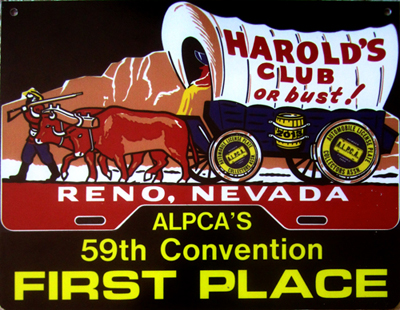 |
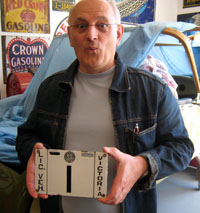 At the Annual Convention of the Automobile License Plate Collector's Association (ALPCA), held in Reno, Nevada in 2013, the 1913 No. 1 City of Victoria plate was entered by Pierre Delacote (its current owner) in the equivalent of the People's Choice Award. At the Annual Convention of the Automobile License Plate Collector's Association (ALPCA), held in Reno, Nevada in 2013, the 1913 No. 1 City of Victoria plate was entered by Pierre Delacote (its current owner) in the equivalent of the People's Choice Award.And guess who won! Congratulations Pierre and thank you to the members of ALPCA for recognising the historical origins of this particular plate. |
*
* * * * |
An interesting sub-set to the story of the No. 6 plate, is that of the "Driver's License" (No. 238) which accompanied it and is made of a similar porcelain enamel. |
Back in 1884, Bylaw No. 100 had made reference to the requirement to obtain two badges from the City, the smaller of which was to be displayed in a conspicuous place inside the vehicle. |
In 1901, Bylaw No. 362 amended this so that a driver now had to display the badge "on his arm or some other conspicuous position". |
Bylaw No. 1313 provides us with the best hint as to its origin as it required that "the badge shall be elliptical metal enamelled badge, 2 1/2 inches in diameter, and the letters shall be not less than 3-4 inches in height, and shall be blue or black on a light ground, and held by a small trap through the buttonhole." |
Of even more interest, Bylaw No. 1313 was amended by the City Council on May 21, 1913, by Bylaw No. 1553, so that the badge would henceforward be "a round solid nickle badge 1 3/4 inches in height and shall be held by a pin affixed in the back thereof and shall be worn on the outside of the lapel o the outer coat and shall contain the words and be in the form of the design thereof which is a schedule to this By-law." |
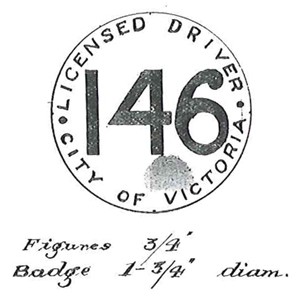 1914 |
Shown at far left is an example of the enamel badge required under Bylaw No. 1313. Less than one year later, this Bylaw was amended in order that the City could begin issuing the "round solid nickle badge" shown at near left. |
That the City would abandon the use of the porcelain badges less than a year after their introduction feeds a theory we here at BCpl8s.ca have been working on for many-a-moon now, and that is that the City also likely abandoned the use of the porcelain licence plates after a year, or two, despite the wording that appeared the various bylaws through to the 1930s. |
| 1901 - 1912 (?) | |
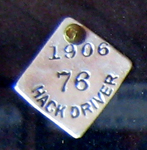 |
In the interests of full disclosure, it is not known where this badge was issued, however, given the date, relatively low number, the number of municipalities that would have been regulating hackney carriages in BC in this era, and the collection it originated from, it is quite possible that it could be from the City of Victoria. At the very least, it is how we imagine the "badges" issued by the City during this period likely looked.
|
| 1913 | |
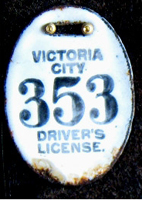 |
It has been suggested that one of the reason's behind the rather quick amendment of City Bylaws in order to make the switch to a round nickle badge was that many hackney carriage operator's complained of the weight and design of the porcelain badges introduced in 1913 as they tended to flop around and bang on their chest when driving, becoming very uncomfortable by the end of a long day. |
| 1914 - 1919 | ||||
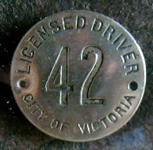 |
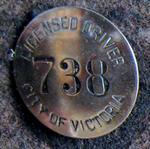 |
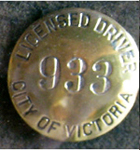 |
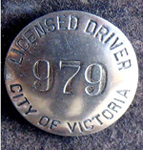 |
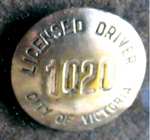 |
| 1920 - 1921 | ||
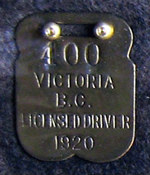 |
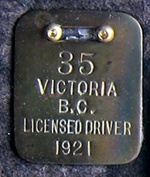 |
|
| 1922 - 1928 | ||||
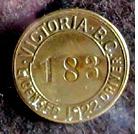 |
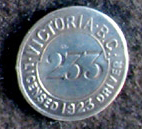 |
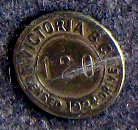 |
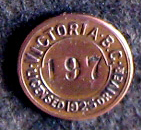 |
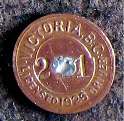 |
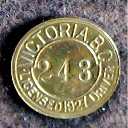 |
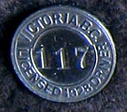 |
|||
|
© Copyright Christopher John
Garrish. All rights reserved.
.jpg)
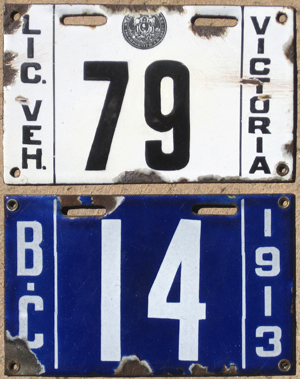


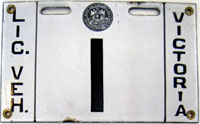
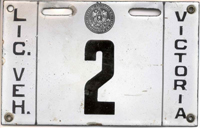
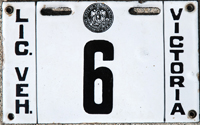
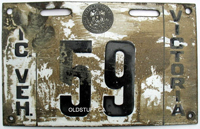
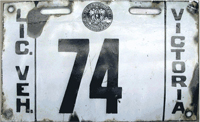

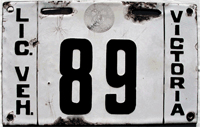
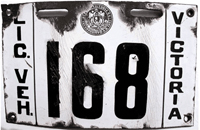
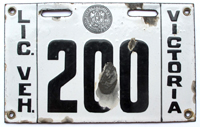
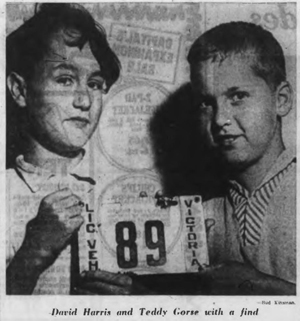 To kill time in the summer of 1964, David Harris and Teddy Gorse (left) biked around their Victoria neighbourhood searching for cars with out of province license plates, which they kept track of in a notebook (we here at BCpl8s.ca get these kids!!).
To kill time in the summer of 1964, David Harris and Teddy Gorse (left) biked around their Victoria neighbourhood searching for cars with out of province license plates, which they kept track of in a notebook (we here at BCpl8s.ca get these kids!!).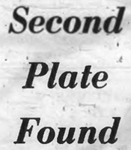 In response, Joe Howroyd came forward to announce that he had the No. 98 City of Victoria license plate that he had similarly unearthered while plowing his Gordon Head farm back in the late-1940s.
In response, Joe Howroyd came forward to announce that he had the No. 98 City of Victoria license plate that he had similarly unearthered while plowing his Gordon Head farm back in the late-1940s.